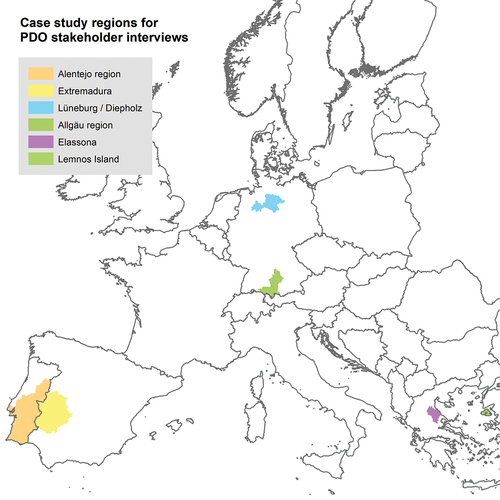Figures & data
Figure 1. Map of Europe highlighting the locations of the six case study regions.

Figure 2. Typical views on extensively managed landscapes from our six case study regions. a) cattle in Ribatejo region, Portugal (photo by Conceição Caldeira); b) terraced fields mixed with oak trees in Extremadura, Spain; c) sheep in the heath meadows around Lüneburg, Germany (photo by Willow on Wikimedia Commons [CC-BY 2.5]); d) semi-mountainous pastures in the Lemnos region close to Mt. Olympus National Park, Greece (photo by Vasileios Deligiannis); e) nutrient-poor grasslands with goats on Lemnos island, Greece (photo by Danae Sfakianou); f) cattle in touristically used alpine pastures in the Allgäu region, Germany (photo by Marlene Haiberger on unsplash).
![Figure 2. Typical views on extensively managed landscapes from our six case study regions. a) cattle in Ribatejo region, Portugal (photo by Conceição Caldeira); b) terraced fields mixed with oak trees in Extremadura, Spain; c) sheep in the heath meadows around Lüneburg, Germany (photo by Willow on Wikimedia Commons [CC-BY 2.5]); d) semi-mountainous pastures in the Lemnos region close to Mt. Olympus National Park, Greece (photo by Vasileios Deligiannis); e) nutrient-poor grasslands with goats on Lemnos island, Greece (photo by Danae Sfakianou); f) cattle in touristically used alpine pastures in the Allgäu region, Germany (photo by Marlene Haiberger on unsplash).](/cms/asset/5663e44b-53c3-4043-a08a-1d6f94c8fbe6/tlus_a_2326321_f0002_oc.jpg)
Table 1. Study regions, their geography, and the included PDO products in these regions.
Table 2. Codes used for structuring the interview material with a detailed description of each code.
Table 3. Result from the ‘code-relations-browser’ from MAXQDA showing the number of overlapping and nearby coded text segments among the nine codes used for the PTA. All codes that have equal to or more than half of the maximum overlaps (38) are emphasized by bold-italic numbers. In the lower half, the six identified phenomena are listed with the number of overlaps given in brackets.
Supplemental Material
Download Zip (636.4 KB)Data availability statement
The interview guideline is available as supplementary material (Annex 1). The original interview responses cannot be made public due to privacy reasons. Instead, summarized interview results, aggregated for each study region, are presented in Annex 2. The coding frequencies needed for the phenomenon-centered text analysis – distinguished by stakeholder types and regions – can be found in Annex 3. Interview responses that illustrate the topic are collected in an anonymous format in Annex 4, also containing the quotes displayed under results.
